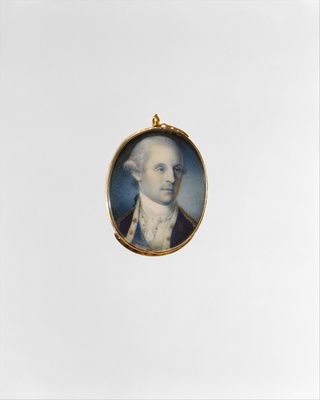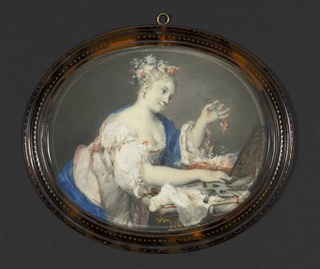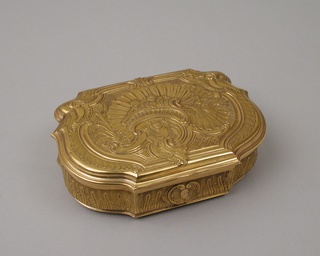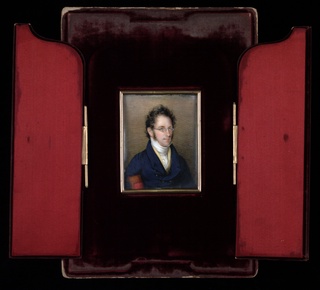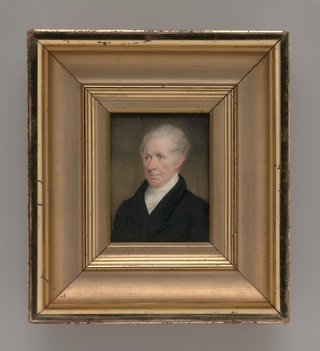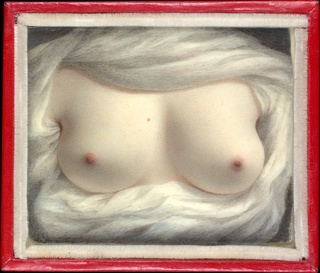Miniature Portraits Unveiled: Ivory's Legacy and Artistic Agency
By Inji Kim•August 2023•12 Minute Read
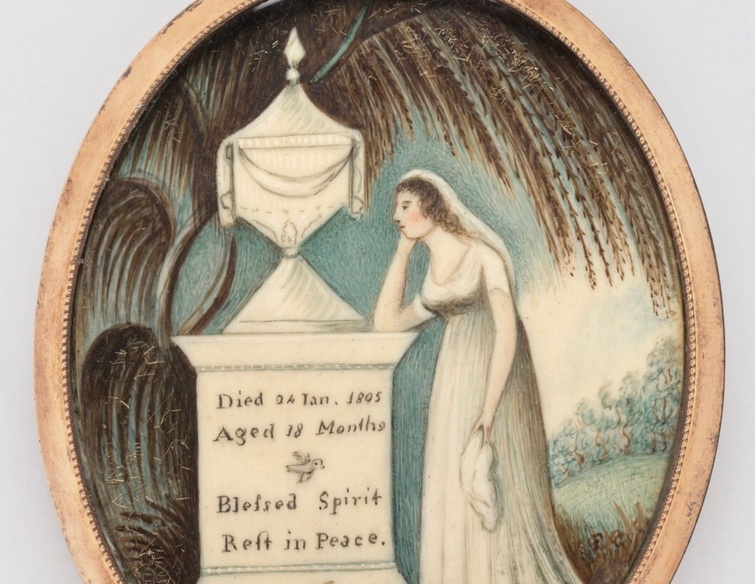
Unknown Artist, Memorial Miniature, early 19th century. Watercolor with hair on ivory. National Gallery of Art, CC0.
An examination of the role of ivory in miniature portraits highlights the contributions of women artists and the complex history of the ivory trade in the United States.
Miniature portraits, perfectly sized pendants that fit into the palm of the viewer's hand, are adorned with meticulous brushstrokes and delicate details. Originally crafted to be worn or carried, these objects are intimately connected to their functions as tokens of affection, mementos, and even reliquaries. Beneath the sentimental surface lies a troubling undercurrent: the material legacy of ivory exposes a history of violence and exploitation. At the same time, in the realm of miniature portraits, women artists found a distinctive avenue for creative expression and financial autonomy. The personal and intimate nature of miniature portraits resonated deeply with both the artists who crafted them and the collectors who cherished them, empowering women to embrace this art form and forge a distinct presence in the art world. These seemingly innocent objects are an entry point to a multifaceted narrative, encompassing notions of artistry, sentimentality, identity, and the historical complexities of trade.
Capturing the Citizens of a New Nation
While European miniature art often fixated on depicting aristocracy and grandeur, American miniature portraits chose a different path, casting the limelight on politicians, merchants, and their families. This shift revealed a newfound desire in the United States to portray and celebrate the private and social connections of ordinary individuals, capturing the essence of a burgeoning democratic society.1 Charles Willson Peale's portrait of George Washington, created around 1777, deviates from the conventional glorification of a prominent general, offering viewers an intimate, close-up view of their commander in chief.
The Peales shaped the trajectory of American artistic expression, not only through generations of painters but also by establishing major art institutions like the Pennsylvania Art Academy and Philadelphia Art Museum. Charles, a member of Washington’s Continental Army, skillfully captured the commanding presence of the general, presenting him in his dignified uniform while they were camped at Valley Forge during the Revolutionary War. This portrait carries a unique significance, as it was a gift for Martha Washington.2 The deliberate choice of a handheld size for the portrait further enhances this closeness, which would have allowed Martha Washington to cradle her husband’s likeness in her own hands and forge a tactile bond with the image. Through this portrait, the essence of Washington's role in the nation's founding is palpable, immortalized not for a grand audience but for an intimate one—his devoted wife.
Complexities of Sentimentality: Portraiture, Whiteness, and Ivory
These miniature portraits became deeply personal mementos, commemorating pivotal family events like births, marriages, and deaths. The form flourished as the nation developed a heightened sensitivity towards capturing and preserving memories. Many portrait miniatures went beyond mere depictions and ventured into a more intimate realm by incorporating hairwork, transforming human hair into elaborate keepsakes. These objects served as tangible and cherished remnants of departed loved ones, when they embarked on a long journey or passed away.3
One such embodiment of sentimentality is this memorial miniature, a creation that delicately weaves strands of a deceased child's hair. Encased within an oval frame adorned with a weeping willow tree, a somber ambiance envelops a grieving mother, her figure draped in the purity of white. With poignant grace, she perches by a child’s neoclassical tomb, pristine and pale. In a departure from traditional portraiture, the artist's focus shifts away from the child, instead capturing the mother's sorrowful presence. This tender miniature likely offered solace on days when physically visiting the grave was not possible. The artwork offers a profound connection, intertwining a physical fragment of the child's essence with an image of the tomb itself. It serves as an intimate act of remembrance, providing an oasis where a deep loss can be cherished and processed.
Unknown Artist, Memorial Miniature, early 19th century. Watercolor with hair on ivory. National Gallery of Art.
The mother's side profile, delineated with a touch of pink, radiates with a warmth that accentuates her very fleshiness, in vivid contrast to the paleness of her attire and the headstone. Through this delicate detail, the artist's vision breathes life into the portrait.4 In this portrayal, we witness a striking juxtaposition—an expression of vitality and the delicate blush of existence embodied in those tender touches of pink, harmonizing with the ethereal essence of the sitter that is further accentuated by the luminous ivory material itself.
The allure of ivory as a medium for miniature portraits resides not only in its physical attributes but also in its remarkable ability to infuse depictions of white, pale skin with a lifelike depth and glow.5 Beneath the allure of ivory was a darker reality—demand that perpetuated an exploitative industry, casting a shadow over its widespread use. As we admire the delicate brushstrokes and ethereal vitality in these miniature portraits, it becomes imperative to confront the complex history of ivory as a material.
Ivory: Luminosity, Exclusivity, and Exploitation in Miniature Portraits
The ivory trade between East Africa and Western centers of manufacture expanded rapidly in the mid-19th century to accommodate a booming industry of manufactured ivory products, including piano keys, billiard balls, combs, and numerous other goods. Throughout the 19th century, ivory was obtained through a commodity chain that extended from the East African interior to the Indian Ocean entrepôt of Zanzibar and eventually to the ivory-cutting factories of the Connecticut River Valley. Ivory's importance extends beyond its economic value; it is deeply embedded in African oral histories, mythologies, and cosmologies. Elephants symbolize fecundity and danger in many African origin stories.6
Historical images preserved by the Ivoryton Library Association offer visual evidence of the scale and impact of ivory processing during this era. Among these records, an advertisement from an 1865 piano key manufacturing factory stands out, shedding light on the origins of these ivories, tracing their path from Africa to American homes.
Unknown Artist, catalogue cover for Julius Pratt & Co. goods, c. 1865. Connecticut Libraries, no restriction on use.
The accompanying catalog cover, presenting the wares of Julius Pratt & Co., features a striking central image—an African man depicted in a tropical setting, one hand grasping a tusk, the other wielding a spear. Adjacent to him, a seated woman engrossed in lacework sits beside a piano. The visual narrative continues with an image of an elephant adorned with a canopied seat and riders at the top left, while to the right, a man stands alongside a large horned bull or ox. These images serve as stark reminders of the interplay between the allure of ivory, the exploitative nature of the industry, and the broader social and cultural contexts in which these miniatures were created. They compel us to deeply reflect upon the racist narratives woven into the history of ivory, laying bare the tangled connections between global trade, artistic consumption, and the far-reaching consequences of unchecked exploitation.
Ivory, harvested with the labor of enslaved individuals in colonial Africa and India, assumes a poignant symbolism within the context of portraiture.7 These objects, far surpassing their status as mere keepsakes, actively perpetuated a broader framework of class and racial dynamics. Through the incorporation of ivory as a backing material, privileged white artists and consumers could visually assert the codes of whiteness, effectively reinforcing their social status and consolidating their power. This artistic choice served to reinforce the association between ivory and whiteness, and thus whiteness and status.
Women Artists: Shaping Identities and Achieving Agency through Miniature Portraits
Within the dynamics of power, exploitation, and artistic expression linked to ivory, women artists in the realm of miniature portraits emerge as notable contributors. Given the fact that women artists have been palpably absent from canonical art history, the continuous records that indicate women artists’ contribution to the genre of miniature portraits become all the more significant.
Venice and Carreira
Among these remarkable artists, the 18th century Venetian artist Rosalba Carreira stands out. Carreira's artistic innovation blossomed from her ability to transform thin ivory wafers, derived from elephant tusks, into captivating canvases for her work. This breakthrough unlocked new artistic possibilities within the medium, propelling Carreira to the forefront of miniature portraiture.
Carreira's mastery elevated miniature portraits beyond mere adornments, granting them a place of prominence on coveted objects like tobacco snuff boxes. These intricately crafted items not only served as fashionable accessories but also became conduits for political exchanges and diplomatic gestures, reflecting the vibrant social and cultural milieu of 18th-century Venice. As a bustling commercial center, the city provided Carreira with a fertile marketplace to showcase her talent for realism. Her exquisite miniature portraits found their way into the hands of the Venetian elite.
The cosmopolitan atmosphere of Venice played a pivotal role in Carreira's success. In the 18th century, Venice's thriving economy revolved around trade in various commodities, including tobacco, which were distributed throughout Europe. As one of the era's main trade products, tobacco fueled Venice's economic growth and cultural exchange. Its prominence in Venetian commerce undoubtedly influenced the patronage and demand for artistic works, including Carreira's miniature portraits.
As we celebrate Carreira's artistic achievements, we must also grapple with the complicated legacy of her work. Being one of the first to recognize the potential of ivory as a medium for miniature portraits, Carreira contributed to the perpetuation of the ivory trade's brutal nature.
Self-Taught Miniature Portraitists
Unlike larger-scale paintings that required access to formal studios or esteemed art institutions, miniature portraits could be crafted within the intimate settings of one's own home, reminiscent of the delicate craftsmanship of lacework. This accessibility empowered women artists to overcome the barriers that traditionally hindered their artistic pursuits and establish themselves as influential contributors to the field as demand for these portraits rose in the United States. Through their skillful execution of miniature portraits, women like Anna Claypoole Peale and Sarah Goodridge defied societal norms and achieved recognition and economic agency that would have otherwise been closed to them.
Anna Claypoole Peale, the niece of Charles Wilson Peale who painted George Washington’s portrait, serves as a prime example of the position held by women artists during this era. With the advantage of her family’s esteemed legacy, Anna gained access to valuable educational resources and influential social circles. Through her own prominence as a miniature portraitist, Peale demonstrated how women artists could attain both recognition and economic agency in the field.8
Sarah Goodridge, a self-taught force in the art world, gained recognition through her miniature portraits on ivory, exhibited in prominent cities like Boston and Washington, D.C. While her skillful portrayals of influential figures such as Daniel Webster and Gilbert Stuart cemented her reputation, Goodridge's artistic journey extended beyond the conventional expectations of her clients.
One striking example of her bold approach is seen in her self-portrait titled Beauty Revealed, which she fearlessly presented to Daniel Webster, a prominent figure of her time. In the portrait, Goodridge daringly reveals her bare breasts, defying long-standing conventions of modesty and redefining the boundaries of artistic representation. What sets this work apart is not merely the subject matter of a female nude, which has been common in Western classical painting, but the shift in context when the artist herself is a woman. This deeply personal gesture hints at a profound connection between the artist and her subject, leaving room for speculation about the nature of their relationship.
Through her self-portrait, Goodridge introduces a subtle but transformative triangulation between herself as the artist, her identity as the model, and the intended viewer. This dynamic alters the traditional power dynamics associated with male artists portraying female nudes, challenging the notion of the male gaze and societal expectations of modesty. In doing so, Goodridge's work becomes a powerful act of self-expression within a male-dominated art world. However, it is essential to carefully analyze the nuances of the portrait's impact, considering both its potential to challenge conventions and the possibility of inadvertently reinforcing certain aspects of traditional representation. The portrait's complexities prompt a fascinating exploration of how art can simultaneously subvert and reify societal norms.
Miniature portraits uniquely offered women artists in the United States a distinct path for creative expression, artistic identity formation, and economic autonomy. However, beyond their personal and sentimental qualities, the material legacy of ivory adds a layer of suffering to the history of these alluring artworks, and sheds light on the disparities that pervaded the early United States.
Inji Kim is a 2023 Curationist Critic of Color. She is a PhD student in Art History at the University of Washington, where she is also pursuing a certificate in Cinema and Media Studies. She studies modern and contemporary art, with a special interest in museology, knowledge circulation, and cultural performance. Inji holds a Master's degree in Art and Museum Studies from Georgetown University, and worked at various museums, galleries, and cultural platforms. She is passionate about teaching and has been co-leading a contemporary art history study abroad program in Belgium, the Netherlands, and Germany. Recently, her writing has been featured in Art & Education and the Nasher Graduate Symposium Compendium.
Citations
Dale Johnson, American Portrait Miniatures in the Many Collection (New York: Metropolitan Museum of Art, 1990).
Carrie Rebora Barratt, “A Brief History of American Portrait Miniatures at The Metropolitan Museum of Art,” American Portrait Miniatures in The Metropolitan Museum of Art (New York: Metropolitan Museum of Art, 2010), pp. 4.
Johnson, 15.
Matthew Pethers, “Portrait Miniatures: Fictionality, Visual Culture, and the Scene of Recognition in Early National America,” Early American Literature 56, no. 3, 2021, pp. 784–785.
Pethers.
Pethers.
Alexandra Celia Kelly, Consuming Ivory Mercantile Legacies of East Africa and New England, 2021.
Anne Sue Hirshorn, “Legacy of Ivory: Anna Claypoole Peale’s Portrait Miniatures,” Bulletin of the Detroit Institute of Arts 64, no. 4, 1989, pp. 22–24.
Inji Kim is a 2023 Curationist Critic of Color. She is a PhD student in Art History at the University of Washington, where she is also pursuing a certificate in Cinema and Media Studies. She studies modern and contemporary art, with a special interest in museology, knowledge circulation, and cultural performance. Inji holds a Master's degree in Art and Museum Studies from Georgetown University, and worked at various museums, galleries, and cultural platforms. She is passionate about teaching and has been co-leading a contemporary art history study abroad program in Belgium, the Netherlands, and Germany. Recently, her writing has been featured in Art & Education and the Nasher Graduate Symposium Compendium.
